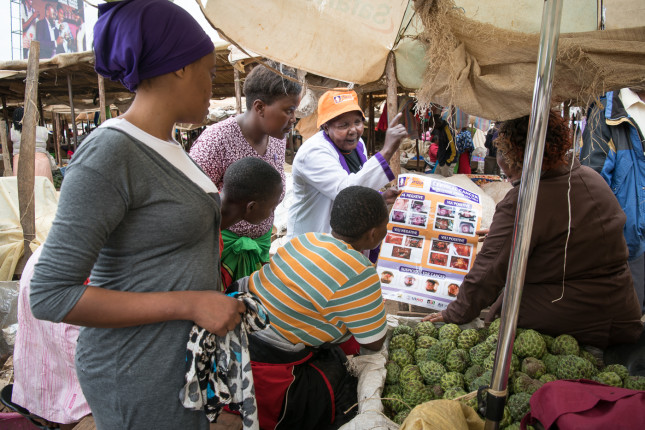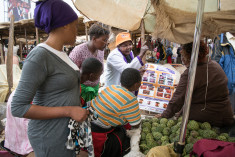-
Integrating Cervical Cancer Prevention into Comprehensive Women’s Health Care
April 29, 2020 By Celina Schocken
Cervical cancer affects 570,000 women a year and kills 311,000. Nine in 10 (88 percent) of the deaths occur in developing countries. This cancer is caused by a common sexually transmitted infection, human papilloma virus (HPV), but is also considered a non-communicable disease (NCD) because of the slower way it presents. Yet, the disease is one of the most preventable and treatable cancers, and cost-effective solutions exist to prevent the disease. Given strong overlaps between HIV and reproductive health, we can and should do more to stop cervical cancer.

Cervical cancer affects 570,000 women a year and kills 311,000. Nine in 10 (88 percent) of the deaths occur in developing countries. This cancer is caused by a common sexually transmitted infection, human papilloma virus (HPV), but is also considered a non-communicable disease (NCD) because of the slower way it presents. Yet, the disease is one of the most preventable and treatable cancers, and cost-effective solutions exist to prevent the disease. Given strong overlaps between HIV and reproductive health, we can and should do more to stop cervical cancer.
The Plan to Eliminate Cervical Cancer as a Public Health Threat
In 2018, the Director-General of the World Health Organization (WHO), Dr. Tedros Adhanom Ghebreyesus, called for the elimination of cervical cancer as a public health threat. WHO developed a cervical cancer elimination strategy, which was slated to be passed at the May 2020 World Health Assembly. The strategy’s goals for 2030 are to:
- Vaccinate 90 percent of girls against HPV by age 15;
- Screen 70 percent of women at the ages of 35 and 45 with a high-precision test; and
- Treat 90 percent of women identified with cervical cancer or precancer.
Cervical cancer presents an unusual opportunity because it is so closely linked with other areas of women’s health, and because it can be prevented with existing tools that work well and are cost effective. Cervical cancer grows slowly over time from the initial HPV infection, and we normally have 10 to 15 years to identify women who are developing the signs of cancer.
HIV-positive women, who are five to six times more likely to develop cervical cancer than the general population, progress from pre-cancer to cancer much more quickly. If these women die of cervical cancer, we risk losing many of the gains achieved by programs like the President’s Emergency Plan for AIDS Relief (PEPFAR) and the Global Fund that have extended the lives of millions of women on anti-retroviral therapy. Because HIV-positive women are at such high risk, cervical cancer screening should be integrated into routine monitoring for HIV.
There is also a strong connection between cervical cancer screening and reproductive health, although it isn’t a perfect overlap. For adolescent reproductive health programs, introducing the HPV vaccine and ensuring girls are vaccinated is important. Health education messages about the importance of routine screening makes sense for young adult women, but we typically do not screen for cervical cancer at the time of pregnancy, unless there is a particular concern. Women ages 35 and older who use family planning services should be offered routine screening at the time they access services. In March 2020, TogetHER for Health, FP2020, and many partners issued a Call to Action to encourage better integration of family planning and cervical cancer programming.
Cervical cancer can also be integrated into non-communicable disease screening programs, including other cancers, hypertension, and diabetes screening.
Tools That Work
A key reason why we can eliminate cervical cancer is because we have the vaccines, diagnostics and treatments to do so, which we don’t have for many other diseases. The HPV vaccine prevents HPV infection, and thus all HPV-related cancers, which include cervical, mouth and throat, anal, and penile cancers. Girls and boys should be vaccinated, but due to funding limitations, GAVI, the Vaccine Alliance, only provides the vaccine for girls. The vaccine is safe and effective, and countries with national vaccination programs like Australia are seeing their cervical cancer rates plunge. Unfortunately, supplies of some of the lower-cost vaccines procured by GAVI and most developing countries are currently running short. But we expect the shortage to resolve when generics become available in a few years.
While the vaccines work well, most women alive today have not been vaccinated, and still face a risk of developing cervical cancer. Even girls who are vaccinated will likely need to be screened as adults, because vaccine efficacy wanes over time, and some types of vaccines are only about 70 percent effective against cervical cancer. The world is moving away from pap smears, which have low sensitivity, to high-sensitivity HPV DNA tests. In low resource settings, there are fast, sensitive tests that cost as little as $5 per test. Another exciting innovation is Automated Visual Evaluation (AVE), in which the provider takes a photo of the cervix, and using machine learning, a computer program evaluates the cervix and can identify cervical cancer. This approach is currently being evaluated in the field after showing encouraging study results. It will likely be introduced in the next couple of years.
The goal of routine screening for women who are 35 and 45 years of age is to identify cervical pre-cancers, which are relatively easy and inexpensive to treat. Again, new technology in the form of thermal ablation burns the pre-cancerous cells in one minute, and the devices run on batteries. This makes a huge difference in our ability to screen and treat women safely and effectively, usually in one visit.
Unfortunately, some women who come for screening will have invasive cancer, and those women need to be treated with a combination of surgery, chemotherapy, and radiation. Countries are scaling up these programs, but access to care is very limited and continues to be a challenge. Access to palliative care is terribly lacking, and many women with cervical cancer die a painful death.
We Can Eliminate Cervical Cancer
The WHO is pushing for the elimination of cervical cancer, because it is the first cancer we can eliminate. We can prevent it, and we can treat it as the disease emerges. Cervical cancer programming can be integrated into existing adolescent health, family planning, and HIV programs, and it should be an integral part of universal health coverage.
The lessons learned as these programs are rolled out will teach us how to offer comprehensive women’s healthcare. As Sally Cowal, Senior Vice President for Global Cancer Control at the American Cancer Society has said, “Women are not body parts. We should have health care that covers all of their needs.”
Read More:
- Take aim at non-communicable diseases to reduce U.S. maternal mortality.
- Cardiovascular disease can be a silent killer during pregnancy and beyond.
- Mothers’ mental health erodes in Nairobi due to many stressors.
- How women with Multiple Sclerosis can navigate pregnancy.
- Pregnant and postpartum women face the hidden danger of high blood pressure.
- Care for maternal health and non-communicable diseases must be integrated.
Celina Schocken is the Executive Director of TogetHER for Health.
Sources: AIDS, Journal of the National Cancer Institute, The Lancet Public Health, TogetHER for Health, World Health Organization.
Photo Credit: TogetHER for Health, Kenya.
 A Publication of the Stimson Center.
A Publication of the Stimson Center.




